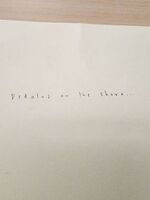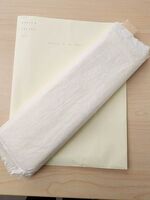Barker, Bitty (chapters)
Object Description
The object I’ve selected was not initially remarkable, something flat - 28 x 10 x 2 cm laid wrapped in a fine white tissue and set atop a cream manila envelope with, “Dedalus on the shore…” written in pencil upon it. Upon unwrapping its layers of tissue revealed an even more ornate layer be-speckled with gold. The final tissue layer, inked with skillful calligraphic penmanship, “Dedalus on the shore / from Ulysses / by James Joyce” and to the left of a red quadrangular Ulysses stamp, “Robert Amos 2017.” Now unwrapped, the object itself appears to be a tall slender book, bound in a shining gold fabric which glistens its patterns behind red embroidered horse drawn carts. The same skillful calligraphic hand has written “Dedalus on the shore” vertically on an orange title card affixed to the glimmering fabric front. Unfolding like an accordion, or a map, in alternating folds the pages reveal themselves to be mostly negative space, sparely painted with hues of blue, brown, teal, violet and indigo. The first white pages introduce the text inside, same calligraphic inkmanship throughout; “from Ulysses by James Joyce.” The art splashed pages that follow read:
“me sits here / with his augur’s rod of ash / in borrowed sandals by day / beside a wild sea / unbeheld in violet night / walking beneath a reign of uncouth stars / I throw this shadow from me / manshape / ineluctable / call it back / endless / Would it be mine form of my form? / Who watches me here? / whoever anywhere will read these written words? / signs on a white field.”
(Amos, 2016.)
The final two pages a taupe hue, are speckled in a distinctly handmade texture and in the top and bottom corners are three square red stamps; one, a modern abbreviation of James Joyce’s name reading “Jam Joy”; below it, the same stylistic Ulysses quadrangle as the outer tissue bore; the third, a logo made of the artist’s last name, reading “Amos.” Finally, the book is signed, “Robert Amos 03.03.16” The back cover bearing the same shimmering fabric as the front, with the only exception being that its bronzed horse-carts twinkle-on unfettered by any text boxes.
Literature Review
A wise Uvic Professor once said of Ulysses, “Each paragraph contains the entire book.” (Ross, 2022). So what makes this particular selection from Proteus so profoundly impactful to artist Robert Amos that he felt compelled to create the art piece Dedalus on the Shore? A modern example of how Ulysses still resonates with readers a century after its publication, Amos’s 2016 contribution to the University of Victoria’s Special Collections is appealing in its brevity and concision. What does this tell us about the impact of this section on Robert Amos and on readers more generally?
Book: Hogan, Patrick Colm. Ulysses and the Poetics of Cognition.
Hogan elucidates that the god the chapter was named after, Proteus is “named for the self-transforming Greek deity,” and that the episode is systematically concerned with identity. (Hogan, 2014).
The book goes on to explain that “the episode suggests what will become a recurring concern in the novel—that the self is far less uniform or singular than we commonly imagine” (Hogan). Dedalus is himself an amalgamation of those who have influenced and informed him.
Peer-reviewed article 1: FitzPatrick, Rose. Code-switching in James Joyce’s Ulysses.
In Rose Fitzpatrick’s article they point out, “Stephen Dedalus is linguistically gifted, which is clear not only in his manipulation of the English language but also in his ability to code-switch as he desires.” FitzPatrick uses the term code-switching to mean his poly-linguistic talents but also his multi-national identity. Expanding on this idea, FitzPatrick explains that “Stephen’s code-switching is also relevant to the language politics found throughout Ulysses. Ultimately, through Stephen’s code-switching Joyce seems to present the potential for a fluid cultural identity.” (FitzPatrick, 2018).
Peer-reviewed article 2: Livorni, Ernesto. Ineluctable Modality of the Visible.
Livorni invites American literary critic and biographer or Joyce into their article by remarking upon the ways which “Richard Ellmann has emphasized the connection between language and a vision of the world: “The attempt to destroy space and time through art becomes a similitude of the attempt to overcome State and Church through language, by rendering them ridiculous, by disclosing their secret natures, by flouting them directly and indirectly.’” (Elllman qtd. in Livorni, 1999.)
Peer-reviewed article 3: McArthur, Murray. Signs on a White Field.
In this article, McArthur discusses how: “Like Saussure and the Structuralists Joyce was concerned with a series of related linguistic issues: the problem of arbitrariness and motivation, the formal and material structure of the sign, the dual axis of synchrony and diachrony, and the complex relationship between language’s two modes, the phonic and the graphic.” (Mcarthur, 1986). Signs and signifiers stand for the hidden meanings implied by the text, where linguistic analysis breaks the words down into their component sounds, structuralists sought to disentangle literature form such constricting boundaries. Dedalus sees himself as Ireland’s next greatest writer, and then spends the majority of Proteus composing with his eyes closed.
Peer-reviewed article 4: Steinburg, Erwin R. Signature of Stephen Dedalus.
In this final article, author Erwin Steinburg invites several noteworthy critics to weigh in on their analysis of the Proteus episode. Firstly classical literary theorist Aristotle and then German philosopher Ernst Alfred Cassirer who famously studied symbolism. Steinburg proposes that Stephen Daedalus thinks “Endless, who would be mine, form of my form?” (48:22), an obvious echo of Aristotle who says:
“It follow that the soul is analogous to the hand; for as the hand is a tool of tools, so the mind is the form of forms and sense the form of sensible things.” (Aristotle qdt. in Steinburg). Erwin then quotes Cassirer writing on Aristotle’s view of knowledge and life; “sense perception, memory, experience, imagination and reason are all linked together by a common bond; they are merely stages and different expressions of one and the same fundamental activity.” (Cassirer qtd. in Steinberg, 1968.) Remarking how: “True of Aristotle, this statement is also true of Stephen’s stream of consciousness in Proteus.” (Steinburg).
Short Paper
Robert Amos’ 2016 art piece Dedalus on the Shore is the newest item in the University of Victoria’s Special Collections Archive and produced a century after James Joyce wrote Ulysses it stands out amid the collection. This local artist’s contribution is but one example of the ways Ulysses continues to resonate with readers a century after its publication. Inspired by the third episode and populated exclusively by quotes from “Proteus,” Robert Amos re-imagines the written narrative from Dedalus’ walk on Sandymount shore into a visual representation with his hand-painted art-piece.
The third episode in Ulysses follows character Stephen Dedalus as he takes a solitary walk along shoreline. The narrative style of this episode switches from omniscient third person to unfiltered stream of consciousness. This shift from a style more typically associated with the Heroic epic to one associated with Freud’s psycho-analysis is one readers would have picked up on immediately. Echoing philosophical discussions at the time that attempted to disentangle experience from our sense perceptions and apprehension from comprehension. Stephen’s thoughts throughout his walk range from memories of his education in Paris, imaginings of a potential visit to his aunt’s house and flit back and forth between the reliability of his senses in perceiving the world around him.
Named after the Greek god of transformation, “Proteus” deals a lot with the Dedalus’s perception of himself - as potential to be Ireland’s next greatest writer - that despite going away to Paris to study literature he’d had to cut his education short when his mother fell ill and he was forced to return to Ireland. Does ones self-identity persist throughout one’s changes and decisions? This thought experiment originates with the paradox of Theseus’ ship in the Odyssey, upon which Ulysses is loosely based. You see, the ship in the Odyssey had been destroyed completely and rebuilt so many times over that no single board or nail on the entire vessel was the same as it was when it originally left port. Nevertheless the name of the vessel (its identity) persisted despite its physical components being transformed. Can Dedalus truly be an artist (Ireland’s own Shakespeare) if he has never had his writing published? Is one’s definition of self therefore dependent on actualizing one’s potential?
Even the location of the episode mirrors this theme of transformation of identity, the shoreline being both a marine and intertidal zone dependent on what time of day one visits. Stephen ruminates on the persistence of reality despite not being seen (his eyes are closed) and extends this query back at himself, if he cannot see others can they still see him? “Proteus” engages the ideas of what is seen versus felt by characters. How our minds perceive ourselves versus how we are perceived by others. How he is perceived by others thematically reoccur throughout the novel. Is the sea-shore a marine environment or land? Depending on the tide’s stage at the time one visits; both.
Works Cited
Amos, Robert. (2016.) Dedalus on the Shore : from Ulysses by James Joyce. Special Collections and University Archives, Mearns-McPherson Library, University of Victoria. N7433.4 A46D43 2016.
FitzPatrick, Rose. "Functions of code-switching in James Joyce’s Ulysses: A case study of “Proteus”." PDF. (2018). Retrieved 3 Nov. 2022.
Hogan, Patrick Colm. Ulysses and the Poetics of Cognition. Routledge, 2014. Retrieved 3 Nov. 2022. https://doi.org/10.4324/9780203762165.
Livorni, Ernesto. “‘Ineluctable Modality of the Visible’: Diaphane in the ‘Proteus’ Episode.” James Joyce Quarterly, vol. 36, no. 2, 1999, pp. 127–69. JSTOR, http://www.jstor.org/stable/25473997. Accessed 3 Nov. 2022.
McArthur, Murray. “‘Signs on a White Field’: Semiotics and Forgery in the ‘Proteus’ Chapter of Ulysses.” ELH, vol. 53, no. 3, 1986, pp. 633–52. JSTOR, https://doi.org/10.2307/2873043. Accessed 3 Nov. 2022.
Ross, Stephen. (2022). Engl 392 Lecture. Ulysses. University of Victoria, Fall Term.
Steinberg, Erwin R. “The Proteus Episode: Signature of Stephen Dedalus.” James Joyce Quarterly, vol. 5, no. 3, 1968, pp. 187–98. JSTOR, http://www.jstor.org/stable/25486700. Accessed 3 Nov. 2022.













